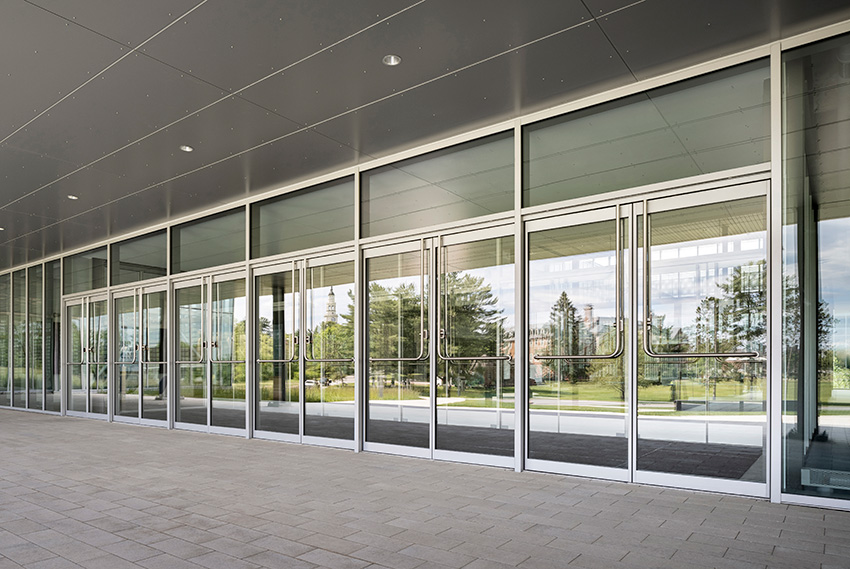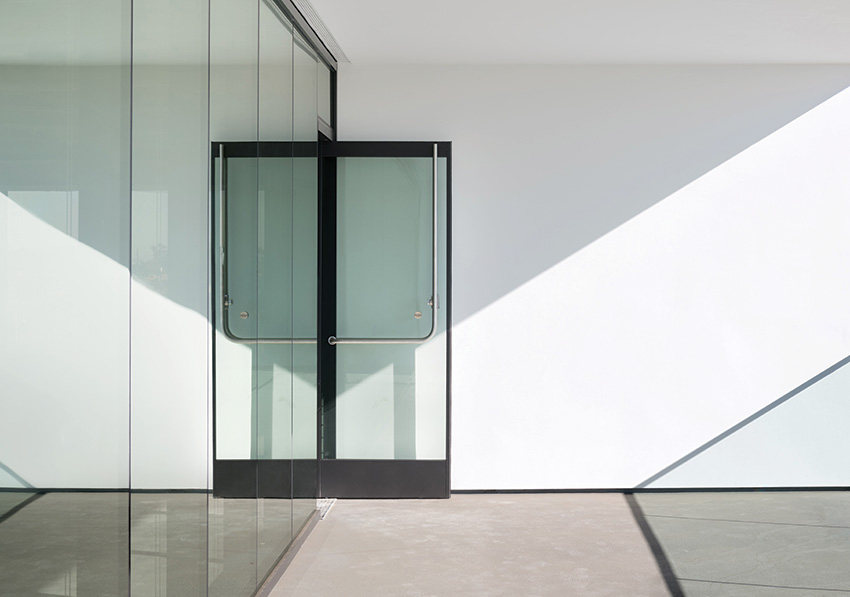Fenestration as Barriers for Better Performance
SLIDING GLASS DOOR AND WALL SYSTEMS
Large-format sliding glass doors are often used in commercial buildings of many types including hospitality, retail, and luxury multifamily projects. They can provide architects with a means to create expansive views and daylighting possibilities with a visually uncluttered and uninterrupted expanse of glass. Products are available that offer a rather sophisticated look that can make a visual design statement with remarkable simplicity.
- Design Features: One of the design benefits of sliding glass door and wall systems is their large panel size. Manufacturers can provide panel heights up to 13 feet tall and widths of up to 7 feet wide, thus creating expansive scale and a look of elegance. To keep the visual “clutter” at bay, ultra-slim panel rails and stiles are available that create a minimal and uniform frame. The sliding panels can stack in front of one another on one or both sides or they can disappear into a wall pocket designed by the architect for that purpose. These various design approaches help buildings achieve both a visual and physical connection between indoor and outdoor spaces with relative ease and simplicity. They come in a range of standard and custom offerings related to size, frame color, frame materials, glass types, and other options.
- Performance: From a performance perspective, sliding glass door and wall systems can be specified to work within the requirements of relevant codes and standards. They are available with a CW Performance Class rating which is ideal for exterior applications where high loads, limits on deflection, and heavy use are expected. They can employ a thermally broken frame with insulating glass up to 1 inch thick and achieve a U-factor of 0.38 or less. These attributes also contribute to achieving a sound transmission rating of STC-33.
- Operation: Some of the best large-format sliding glass door systems use a bottom rolling mechanism with stainless-steel wheels and a precisely engineered stainless-steel track. This helps the large sliding panels, which can weigh up to 700 pounds, move rather effortlessly with a one-handed operation. That is because panel loads are evenly distributed across the bottom rolling components resulting in a fluid, frictionless glide. The track is set into a sill which may be flush with the surrounding floor surfaces or can be raised for greater protection from wind, rain, and other weather.
- Hardware: The sliding operation of the doors means that everything needs to be flat or recessed on the panels so as not to conflict with the proper door movement. This includes the hardware that operates the door, so manufacturers provide integrated, flat handles made of metal including stainless steel. Since the handle is integral to the door, so is the locking hardware. While there are different ways to use locking hardware, the preferred approach is for a multipoint locking mechanism – internal hardware that locks the sliding panel into place at the top and bottom of the frame.
BI-FOLDING GLASS DOOR AND WALL SYSTEM
Bi-folding glass doors use glazed panels that can enclose and open up a variety of interior and exterior spaces. They can be configured into a small grouping for a wide door opening or can span across an entire wall of a facade. A bi-folding glass door or wall system consists of a number of hinged panels that fold together and then slide to one or both sides of the opening. This makes them desirable for many different building types ranging from multifamily, hotel and spa, restaurants, retail spaces, and institutional buildings including K-12 schools and higher education projects.
- Design Features: Unlike sliding glass doors which typically keep at least one panel fixed, bi-folding systems can all move and be stacked out of the way to create a full opening. The panels may be hinged together in pairs or in a large number of connected panels. Many opening configurations are possible with inward or outward swinging options. A locking swing panel can be incorporated into a run of bi-fold doors as a swing door for easy entry or egress within the wall. Like sliding glass doors, bi-folding systems also come in a range of standard and custom offerings related to size, frame color, frame materials, glass types, and other options. Some are available with distinctly slim vertical and horizontal panel rails that reduce visible components, produce a minimalistic aesthetic, and maximize views. When closed, door hinges are completely concealed to deliver an elegant and streamlined look.
- Panel Attributes: Since bi-fold doors are a fundamentally different, albeit similar, product compared to sliding glass doors, the panels in bi-fold systems are more commonly smaller and more frequent than in sliding glass doors. While the specific dimensions and attributes of panels can certainly differ between manufacturers, it is possible to find that the maximum frame height is 12 feet, and the maximum panel width is up to 4 feet. Weight is certainly a factor for the proper operation of the doors, so a maximum panel weight of 200 pounds can be expected. Similarly, there is a practical limit on how many connected panels make sense before they become too unwieldy to operate. Typically, that equates to a maximum of 9 connected panels per jamb (i.e., 18 per opening with two jambs).
- Operation: Bi-fold doors move differently than sliding door systems but can be just as easy to use and design into a building. A bottom rolling system is an option on sliding doors that eliminates added loading on the beam or header above the opening. Some incorporate compensating channels and adjustable spacers to fine-tune the operation for smooth movement and ease of use. The bottom track for bi-fold doors is set into a sill which may be flush with the surrounding floor surfaces or can be raised for greater protection from wind, rain, and other weather.
- Performance: Bi-folding glass door and wall systems have fairly comparable performance attributes compared to sliding door systems. They are also available with a CW Performance Class rating which is ideal for exterior applications where high loads, limits on deflection, and heavy use are expected. They similarly employ a thermally broken frame with insulating glass up to 1 inch thick and achieve a U-factor of 0.36 and a sound transmission rating of STC-32.
It is important to note that bi-folding glass doors are always stacked perpendicular to the opening. The amount of space that the folding doors will take away from the opening is dependent on the number of panels, panel width, height, and thickness. There are a multitude of configuration options with paired panels allowing for the best flexibility in configuration.

Photo courtesy of CRL; © Trent Bell
Glazed entrance systems can provide an attractive, contemporary, and welcoming building entry and still meet the water, air, and thermal barrier requirements needed when the doors are closed.
GLAZED ENTRANCE SYSTEMS
A great example of glazing systems that are widely used and need to address building envelope barrier requirements are swinging door glass entrance systems. These are often sought after as a visual focal point because they create an inviting sense of transparency leading into the building while offering contemporary, elegant all-glass aesthetics. Hence, many commercial, institutional, and industrial buildings incorporate glass entrance systems on the main floor. While these are fairly common, although some have more distinctive looks than others, there are real differences in the way these types of entrance products perform. In the case of energy performance and code compliance, attention needs to be placed on the specification of all of the component parts and materials of these glazed entrance systems.
Achieving the desired level of performance is based fundamentally on three things: the structural and material integrity of the aluminum frame and glass; the insulating value of the system; and the ability to prevent air and water infiltration through the system. Fortunately, there are products available that address all three of these criteria and manage to do so with great aesthetic qualities. For example, there are ultra-narrow stile entrance systems available that provide an elegant, all-glass appearance, while still delivering exceptional thermal performance normally found in full-frame doors. Excellent thermal performance translates to U-factors as low as 0.43 to help control heat transfer. This is achieved in part by allowing insulating glass units (IGU) to be used that are up to 1 inch thick. In addition, such entrance systems can demonstrate that they meet or exceed the air infiltration requirements of the International Energy Conservation Code (IECC) and ASHRAE 90.1, both of which contain mandatory provisions on this topic. They can also be specified to pass ASTM E331 water penetration testing.
When it comes to the hardware used for door pulls and panic devices, there are options in this regard too. Commonly, such door hardware is attached directly to the frame. However, some manufacturers have developed a means to secure door pull hardware directly onto 1-inch insulating glass panels using unique through-glass fittings. Styles include sleek tubular panic devices that yield an attractive floating-on-air appearance because the handles don’t have to be attached to door stiles. This provides an added aesthetic and functional benefit without compromising the performance of the doors. That means architects don’t have to sacrifice aesthetics in place of thermal performance.
Other options for such systems include premium door cladding in customizable finishes to blend with or accentuate any design intent. In terms of size, doors can be fabricated successfully up to 10 feet in height. The frame system and the threshold should always include thermal breaks for best performance.
By specifying an all-glass entrance system with the appropriate details, the glass composition of the surrounding framing system can match the entrance system, thus avoiding high variations in either performance or looks. Maria A. Gomez, Principal with GFF Architects sums it up this way, “The ultra-narrow stile entrance products we have specified solve the requirement for thermal performance and weather protection while maintaining an upscale look.”
Notice










